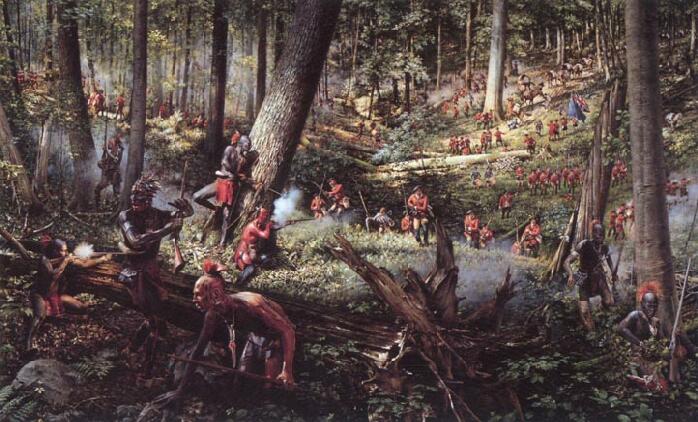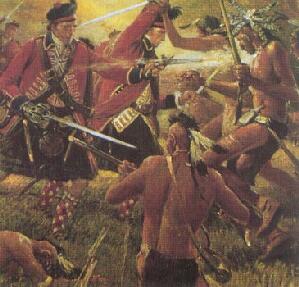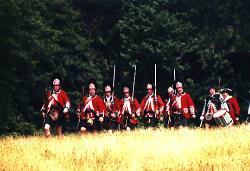The Battle of Bushy Run
... A French & Indian War Epilogue ...



Print by Robert Griffing
Now, it was called Fort Pitt. The mighty forks of the Ohio River, so
critical to control of the western Pennsylvania frontier, were in the hands of
the French & their Native allies no more. Fort Duquesne had fallen ... Fort
Pitt stood in its stead.
Still, it was a hotbed of contention. For the British garrison,
under siege by an Indian alliance, it could soon be a tomb. Canada may have
surrendered in 1760, but that succeeded only in cooling the conflict between two
great European powers, England & France. Within the wilderness, the war was
far from over. It merely changed names. It now was Pontiac's Rebellion, named
after the Ottawa chief who forged an alliance in the Old Northwest. With France
waiting for an opportunity to present itself, the war in the wilderness waged
on.
Departing Carlisle, PA on the 18th of July, 1763, was a relief
force of some 450 Highland and Royal American forces, ably led by Colonel Henry
Bouquet, who earlier had carved this venue through the wilderness and then built
Fort Ligonier. As these troops marched, Fort
Pitt, already being heavily harassed, came under full siege. Entrapped within were nearly 1400 souls,
mostly panic-stricken frontier families who had fled there seeking safe haven
from marauding war parties.
Large contingents of Native forces made communication - into or out of the fort
- impossible. As the Bouquet
column pushed westward, it had no idea what lay ahead. Reaching the frontier
post at Bedford, 30 frontiersman signed on as scouts.
Earlier, in 1755, it had been General Braddock plodding along in
the forest, expecting ambush. It came, all too soon, and resulted in the Braddock's Defeat debacle. Now, it seemed it
was Bouquet's turn. Though his force was comprised of grizzled veterans, many
were wounded or sick. He traded in the invalids for the gruff frontiersmen. The
ambush could come at any turn. The addition of the frontiersmen was the only
insurance against the inevitable.
Upon reaching Ligonier, on August 2, he further lightened his
load by leaving behind his oxen, artillery, and supply wagons. With no word from
Pitt, and the Indians certainly aware of his presence, the next 40 miles must be
covered as quickly as possible. Early warning, courtesy of the newly obtained
scouts, might be just the tonic to avert disaster.
It was to become a situation that closely resembled the
predicament of Braddock years earlier ... an advance guard ran into hostiles,
support was sent forward, and after some stiff firing, a bayonet charge sent the
Indians from whence they had come. The apparent successful repulse was a ruse,
for almost immediately renewed fire broke out,
from the woods on both flanks and the rear of the main British force. It was
Braddock's Defeat all over again ... or was it? It certainly could have been,
but the difference here was the maintenance of order. And that occurrence rests
squarely on the shoulders of the troops' confidence in their commander. Bouquet formed up in a
near-hollow square on a hillside. Indians dashed forward. Fire was exchanged. Often a bayonet charge
put an end to things for a time. The scenario repeated ... all day.
It was an almost even match, as it was a force of some 400
Indians opposing an equal number of His Majesty's troops. Bouquet decided upon
trickery for day two. He feigned a retreat, lured the Indians in, then hit them
on the flanks with his light infantry companies. The maneuver carried the day.
Though Indian casualties were lighter than that of the British, the Battle of
Bushy Run, August 5 & 6, 1763, was over, and broke the back of Indian
resistance in these parts. Fort Pitt was relieved. The settlements came. A great
city would one day stand at this fork in a wilderness river.
The years have gone by, and the landscape may have changed, but,
to this day, there are those who remember and who commemorate the event ... from
both sides. There is an annual re-enactment, and a special bunch who relive
those days through their tales. Read on:
|
An "eyewitness" account - from an
imaginary participant! |
|
 The year
was 1763 and although the 77th Regiment of Foote, and our Lads we know
so well, the Grenadier Company, had been to the Caribbean, their forces
depleted with death and sickness, since we last heard of them toward the
end of the Seven Year's War; our Lads were fit enough to be called back
into active duty. For out of the West in 1763 came a savage horde led by
Chief Pontiac. Pontiac had united the Native Peoples and with the aide
of renegades and the likes, he swept through the Ohio country, into
Pennsylvania and lay siege to Fort Pitt. The year
was 1763 and although the 77th Regiment of Foote, and our Lads we know
so well, the Grenadier Company, had been to the Caribbean, their forces
depleted with death and sickness, since we last heard of them toward the
end of the Seven Year's War; our Lads were fit enough to be called back
into active duty. For out of the West in 1763 came a savage horde led by
Chief Pontiac. Pontiac had united the Native Peoples and with the aide
of renegades and the likes, he swept through the Ohio country, into
Pennsylvania and lay siege to Fort Pitt.
As this siege was underway, more Natives pushed east and there on a
ridge at what was called Bushy Run Station, they were stopped by a
combined force of the 77th, remnants of the 42nd, and the 60th, all led
by Colonel Henri Bouquet, that same Bouquet who had led Our Lads, our
MacWilliam lads over the Pennsylvania mountains in 1758 on the Forbes
Expedition.
On August 4, as the British troops had marched about 17 miles, at 1
o'clock in the afternoon, the advance guard was attacked by the Savages.
Flags, Tales and Seamus, part of that guard, fell back and Col. Bouquet
sent the 42nd forward to repulse the savages until the troops and
strategy was set. The troops moved forward, but being attacked on all
flanks, fell back to protect the convoy, part of that convoy being the
famous "flour bags" which were to be a boon to His Majesty's
troops.
Sgt. MacWilliam, Pvt. Davey Gunn and all the Grenadiers formed an
extended line, keeping up a heavy fire as troops from the 42nd and 60th
took up flanking positions. The cousins never fought harder and never
with more comradeship as the 77th volley fired, making huge swaths
through the brush to dispense of the attackers, and our three longhunter
heroes, Tales, Seamus, and Flags, picked their targets with resolve,
marking their targets with bloody lead.
Uncle Quasi was with the convoy, he having a vested interest in the
supplies, always a Scot with an eye to turn a shilling; when upon the
beginning of the attack, out of the forest came Uncle Angus and his
sheep, Mother Ewe in the lead. After a quick conversation between the
two, they knew that this was not a fight for their type of tactics, so
they pitched in to aid the wounded and give sustenance and liquid
refreshment as the battle raged on for the next 7 hours. For, the
musketry, screams, savage yelps, guttural commands, the crack of rifles,
continued to near dark. All the years of friendship and blood relations
came to fruition in that 7 hour time as the MacWilliam Lads supported
and aided each other and the contingent of soldiers. 'Tis sad to note
that the next time the Lads would be in Battle, it would be against each
other. Oh, the battle can be dissected and discussed at length in this
forum. The number of dead and wounded can be reported. The names of
those killed and wounded such as Peebles and Graham can be told. But,
that is not what's important in this tale....the foreboding of the
future is what must be looked to. All the years of friendship and blood relations
came to fruition in that 7 hour time as the MacWilliam Lads supported
and aided each other and the contingent of soldiers. 'Tis sad to note
that the next time the Lads would be in Battle, it would be against each
other. Oh, the battle can be dissected and discussed at length in this
forum. The number of dead and wounded can be reported. The names of
those killed and wounded such as Peebles and Graham can be told. But,
that is not what's important in this tale....the foreboding of the
future is what must be looked to.
That evening, by the light of the stars and moon, the canvas was brought
up and the streets were set in a square with the officers' tents in the
center. At the top of the ridge where the battle had raged during the
day of the 4th, a "flour bag" redoubt was constructed. So
that, as the dawning of the 5th of August came forth, the camp was
protected by an angled wall built of large sacks filled with flour and
laid on their sides like brick. Muskets and bayonets gleamed behind this
make shift redoubt, and it was no surprise when as the sun began to
climb, amid the groans of the wounded British troops, the yelp and cries
of the Savages come forth from the forest to once again attack. From a
distance they attacked, attempting to surround the camp, but then
massing their heathen forces at one point.
The Colonel, Swiss by birth, from a line of Swiss mercenaries (much like
Flags and Tales whose immigrant German father's grandfather had emigrated
from that same Swiss area a hundred years before); this Colonel Bouquet,
cold and calculating under fire, sent the troops out with drums beating
and colors flying. Another Grant's Defeat, one might suspect with a
groan. But no, a feint to the front of the savages, a retreat back
toward the "flour bag fort". Sgt. MacWilliam with brother Gunn
beside him, and his brave lads, the Sgt. shouting "to the right
about face....stand fast lads, stand fast. Let the bloody savages come a
bit closer!" But no, a feint to the front of the savages, a retreat back
toward the "flour bag fort". Sgt. MacWilliam with brother Gunn
beside him, and his brave lads, the Sgt. shouting "to the right
about face....stand fast lads, stand fast. Let the bloody savages come a
bit closer!"
Then, the coup de grace, as hidden troops to the right, flank the
savages on the left. A sweep from the lights, Major Campbell's
troops....cousin to our own Lieut. Campbell of the 77th Grenadiers, and
it was over quickly. Many of the longhunters and scouts fell into their
woods ways and moved forward to take scalps and booty from the dead.
There are those that say our very own Flags, Tales and Seamus were among
them. For though these cousins were at once men of means and purpose in
their home provinces east of the Susquehanna, their ways of battle were
bred into them from the frontier and wilds. And with that, the savage
force was broken, and Pontiac's Rebellion failed, creating a safe haven
once again for all those colonists of the British Crown.
Colonel Bouquet wrote lightly in his letters of this two day
battle....at one point stating "I hope that we shall no more be
disturbed......" ~ courtesy
of Mark Hagenbuch/photos by Susan Gable
|
|
Extracted from The
Battle of Bushy Run.....a Supplement to the Chronicles on our
Mohican WWWboard |
Be a part of History!
|
GETTING THERE! |
|
Bushy Run Battlefield is located on
State Route 993 near Jeannette, Pennsylvania - SE of Pittsburgh. Open year 'round - though please make an appointment to enter the
Visitors' Center between Nov. 1 & April 1 - and features special
events, educational programs, and both guided & self-guided tours over historic hiking
trails. Call 1-724-527-5584 or see The Bushy Run
Battlefield Web Site for more information. |

Next In The History Series: COLONIAL ERA PHOTOS ... Glimpses Into The Life & Times
   

|